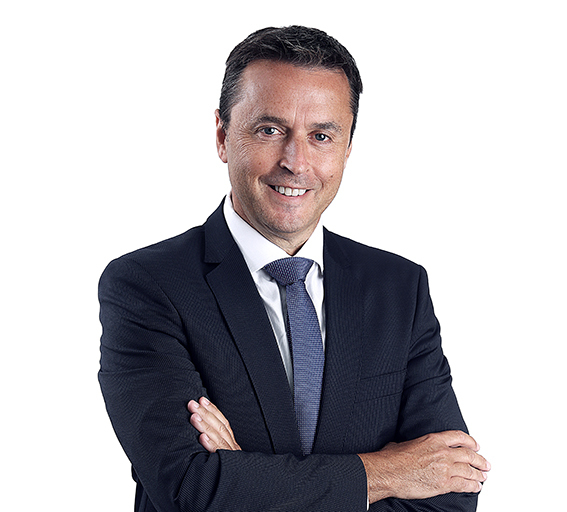Coronavirus has redefined prime property
The property market catchcry "location, location, location" has been disrupted by coronavirus, according to Andrew Schwartz, Group Managing Director of property debt investor, Qualitas.
With the boom in virtual working transforming swathes of suburbia into a concoction of home offices, gyms in garages and DIY drinking establishments, A-grade commercial property may not necessarily be viewed in the same light going forward, he says.
Read on to see the highlights from our Q&A where Andrew discusses the impact on the property debt market, how the Qualitas Real Estate Income Fund (ASX:QRI) is navigating this cycle, which property he favours and early lessons from the pandemic. You can access the full video at the bottom of the page.

Image: Andrew Schwartz, Group Managing Director & Founder, Qualitas
How has the real estate debt market been impacted by COVID-19?
In respect of COVID and the effect on property, what it really does is redefine the term prime property. Whereas previously people would have thought about prime property as perhaps an office asset on Collins Street, it now makes you look directly at where the source of income is from the property itself.
Prime property has been decoupled from location to looking at where the source of income is. So assets such as an industrial asset or a food manufacturing asset might be considered to be more prime at this particular point of time as a result of COVID itself.
Our view is that we're really thinking that the pandemic and the lockdown effects might be in place for a six month period. That's really working off the most recent government guidance statements.
How does that affect the various property assets you've invested in and what about pricing conditions?
Investment assets such as hotels and leisure-related activities would be more impacted as a result of COVID. And there'll be other assets that we consider to be investment class such as industrial or assets that have long-term secure income that we see as benefiting from COVID.
What we are finding now is that perhaps a loan that would have been written at 65% loan to value and 6.0% or 6.5% to our gross return might now be literally at 50 or 55% loan to value with a plus 100 to 200 basis points relative to pre-COVID pricing.
While yields seem more attractive, how do you measure the risk given many businesses are struggling with cashflow?
One really needs to look at the underlying security itself. So QRI has three primary classes of assets. The first one being the investment loans. And those investment loans do source income directly from the property themselves. So perhaps unlike a traditional debt fund that might have corporate bonds, corporate receivables, that's not the nature of QRI. It is a fund that takes mortgages on property and sources income, not just from tenant-related activities but also from the borrower.
The types of borrowers that have taken on loans from QRI tend to be those that are mid-sized borrowers, who have quite substantial levels of diversified assets. So those investment loans really benefit from the fact that the borrowers themselves have wider pools of underlying securities and ratios that exist. And 98% of our total loans are supported by personal guarantees and accordingly, you're really getting the benefit of wider assets within the group.
Approximately half the loans have the benefit of an interest reserve account and what that enables us to do is to the extent that a borrower did find themselves in trouble we can draw upon that enabled the interest to keep getting paid and for the asset to be dealt with at the underlying asset level as well.
Have you seen any stressed loans in your portfolio?
We announced a portfolio update to the ASX on 16 April 2020. What we did note in there is we have got one loan at the moment that we are restructuring. That particular line represents 1.2% of the total assets of the portfolio and we are restructuring at the moment in terms of looking at the underlying borrower, putting more equity into the transaction itself. We do feel that we are well secured on that particular position, but we also feel for reasons confidential to the borrower that they could do with more recapitalisation at the underlying asset level itself.
QRI had an NTA at 31 March of $1.60 but the share price has been trading at a $1.40. Can you help explain this disconnect?
It's hard for me to explain the disconnect because we think the NTA is $1.60 but I suspect the core issue there is really there's been a systemic setback in equity markets across the board. And I think that not just QRI, but really all the credit LITs and LICs are currently trading below NTA. I do think it's really a case of those that require liquidity could be effectively selling the stock at this particular point of time.
I think that conditions for lenders are becoming more favourable in terms of pricing at the loan level, which if that is correct should feed through into higher returns for a trust such as QRI as well. But we are very focused on narrowing the discount; we also announced in the last couple of weeks that we're prepared to undertake unit buybacks. Those unit buybacks are really designed to close the gap between the unit price and the actual NTA to the maximum extent we can.
Do you expect dividends to continue at the same ~6% level?
It's hard for me to make a forecast obviously given ASX listing rules. but I will say a couple of things that are at a very high level. Our portfolio was 20% in the form of cash as at 31 March. So the more we deploy that cash, the more accretive it will be to the total return of the fund.
The second aspect is that we've seen a lot of the local and offshore competition come out of the alternative debt market. And as a result of that, there's more favourable risk premium pricing attaching to new loans. So I think that would go in favour of future yields.
And the third aspect is, that the average maturity of our underlying asset positions is approximately just a little bit over six months. That gives us this ability to set terms and conditions based on the prevailing environment. Not necessarily in an opportunistic way but rather to get back on a solid, more normalised pricing, which again, to the extent we can achieve that would be favourable to the underlying return of QRI.
Looking over a 3-5 year cycle, which types of assets do you think will be most attractive from a real estate debt return perspective?
I continue to really like residential. I think that going into COVID the residential market was already in some form of equilibrium. A lot of our residential market is driven off immigration and clearly immigration is going to be a lot lower over the next one to two years relative to what it has been in the past.
I think it would be a big call to say that we're going to have no immigration for in perpetuity. Immigration will make a comeback and I think that residential property is always going to be a very defensive type of asset class within the property sector.
We really like industrial; the work from home and online shopping boom is redefining industrial in many ways. Property that's associated with digital data centres will continue to find favour. Properties that enjoy a triple net lease from government-related income or food manufacturing will continue to do extremely well.
And I think in the shorter term challenged property will be areas such as hospitality and leisure and retail could really find themselves having to work through this particular phase of the market.
What lessons can we take out of this particular cycle, relative to previous cycles?
This is the third major cycle that I've personally worked through and it's interesting to compare what I think of the longer-lasting effects of this cycle compared to other down markets that I have experienced. And I think the things that are similar to previous cycles is, for borrowers to think about the amount of debt that they take on not just at the asset level but at the corporate level. Lenders do not underwrite growth and I think thankfully QRI has not underwritten asset growth in making any of its decisions.
Also, remember that time is your best friend when it comes to property in respect of working through the particular cycle. But I think that main difference between this event and say 1991, just to show my age and also 2008 is that this is very much an event-driven outcome and there are some sectors of the economy such as hotels and leisure-related activities and those that rely on patronage from what is COVID-effected income that will take longer to recover through this particular event. That's probably what I see as the long term outcome of the COVID pandemic.
Watch the extended interview
In the extended interview, Andrew discusses the following additional points:
- How QRI approaches diversification and the restructuring of loans (9:27)
- Listed versus unlisted valuations (16:27)
- Competition in lending (22:41)
- Views on the government's response to assist landlords and businesses (26:52)
Looking for regular income and diversification?
The Qualitas Real Estate Income Fund (ASX:QRI) aims to deliver investors with a regular stream of income with the added benefit of diversification beyond shares and traditional property investments. Click 'Contact" below to find out more.



